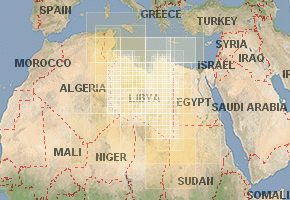موقع خاص بالخرائط الطبوغرافية mapstor

Welcome! We offer topographic maps issued by military and state agencies of Europe, US, Russia in the 19-20th centuries. Many of these topographic maps were used for conducting military operations during 1st and 2d World Wars, Cold War. Maps describe the areas shown in detail and are up-to-date for many parts of the world.
All maps have a corresponding georeferenced files and are compiled to coverspecific countries, regions of the world and tourist destinations. Each map set is accompanied by area facts, graphic information about the maps available, and map fragments for a preview of each map. See more about our product and services and read articles about topographic maps and the history of cartography.
Topographic maps coverage for Google Earth is available here.
الخرائط الطبوغرافية في ليبيا
The topographic map set of Libya contains maps of El-Hamra Plateau, Jefara maps, Amsak-Settafed Range maps, maps of the mountain Thummo, Ben Guneima Plateau maps, El-Harudj-al-Aswad maps, Barka al-Baida maps, Tibesti maps and Bette maps. Besides you can find in the set maps of Tripoli, Sousa maps, Leptis Magna maps, Sirte maps, Sabrata maps, Gdames maps, Qasr and Tokru maps.
Libya is a country in North Africa, located on the Mediterranean coast. Libya borders on Algeria in the west, Tunisia in the north-west, Chad and Niger in the south, Sudan in the south-east and Egypt in the east. In the north, Libya is washed by the Mediterranean Sea. The area of Libya is 1,759,540 sq km.
Relief. Libya is predominantly a desert country. Over 95% of its territory is occupied by sandy and stony deserts of the Sahara tropical area. It is only along the western Mediterranean coast (from the border with Tunisia to Cape Al-Barq) and along the eastern coast that deserts change into subtropical semideserts and even landscapes typical for the dry subtropical Mediterranean area. The Sidra Bay, the only large bay, runs deep across the country.
Mountains. Most of the country is covered by plateaus and plains with altitudes of up to 200-600 m, separated by vast lows. In the north-west, in Tripolitania, lies the El-Hamra Plateau. The northern edge of the plateau ends with the Nefusa ledge (up to 719 m high), which slopes abruptly to the coastal plain, the continuation of the Tunisian lowland of Jefara. In the south, this plateau rises sharply above the basins of the Fezzan filled with sand - Ubari and Murzuk. These two sand massifs in Western Libya cut across the Amsak-Settafed Range. Western Libya is separated from the eastern part of the country by several mountain ranges and ridges - Mount Thumm near the border with Niger (1,043 m), the Ben Guneima Plateau (740 m) and the El-Harudj-al-Aswad Range (1,200 m) in the middle of the country. In the north lie the Cyrenaica's Barka al-Baida Mountains (an average height of 500-600 m). The entire eastern part of the country, except the Barka al-Baida Mountains, is occupied by the Sahara desert. Volcano Bette (2,286 m) is the highest peak of the country, situated in the south, near the border with Chad, on the spur of the volcanic Tibesti Highlands.
Rivers. In Libya, there are no rivers with a perennial drain, but there are a large number of ueds, dry valleys of ancient rivers.
National parks and reserves. Important national parks include the Kuf National Park.
Sightseeing.
The Libyan capital, Tripoli, was founded by Phoenicians in the 7th century BC under the name of Oea. Nowadays it is an amazingly beautiful city. The old part of the city still has its special appearance typical for many cities of the Arab East - low houses with flat roofs, minarets of mosques shooting up in the sky and colorful hustle-bustle bazaars.
The City of Sousa (Apollonia) has been long known for its old city wall, but now it is in a poor condition, almost ruined. Within the city walls, there is a theater, baths, a central street and the ruins of a Byzantine palace.
Other notable historic cities in the country include Leptis Magna (120 km east of Tripoli), Sirte (245 km east of Benjazi), Sabrata (60 km west of Tripoli) and Gdames (Gadames or “Pearl Desert”) located in a desert area 800 km south of the city of Tripoli.
Tourism. Because of the complicated political situation in the country, the tourism industry is very poorly developed. Each year Libya is visited by approximately 88,000 tourists. Sights that enjoy the greatest popularity include Qasr (a museum of mosaics and a Turkish fort), Leptis Magna (the largest ancient archaeological site in Africa, founded by Phoenicians in 900 BC), Tokru and many more.
Climate. For most of Libya's territory, the dominant climate is a tropical desert climate, while the northern part is dominated by the Mediterranean subtropical climate. Along the coast, the average January temperature is about +12°C, while the average July temperature ranges from +26°C to +29°C. Throughout the rest of the territory, the average July temperature rises up to +36°C, but at night the air cools down to zero and even lower. The amount of rainfall the country receives is about 250-350 mm per year, while the Al-Akhdar Plateau gets up to 600 mm of rainfall. In some areas, there is no rain for several years running.

ليست هناك تعليقات:
إرسال تعليق